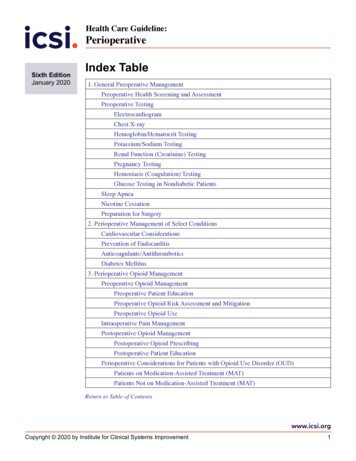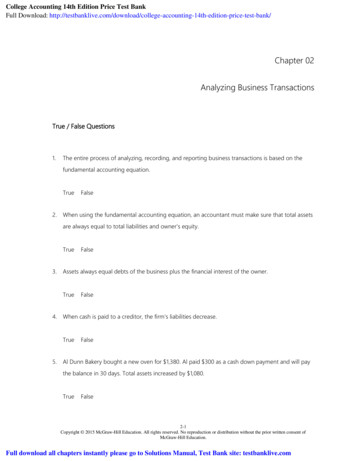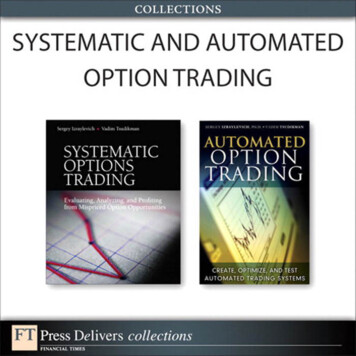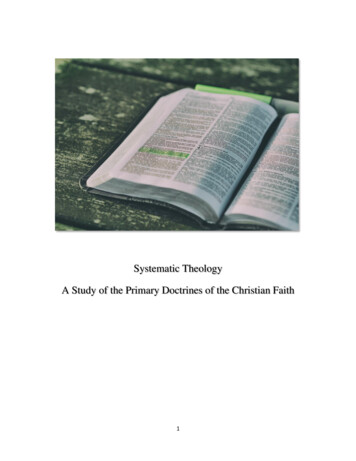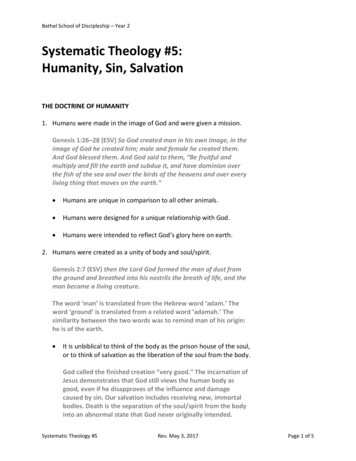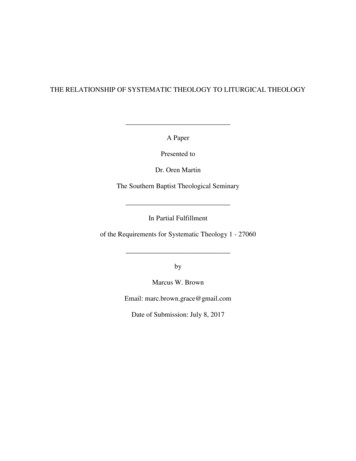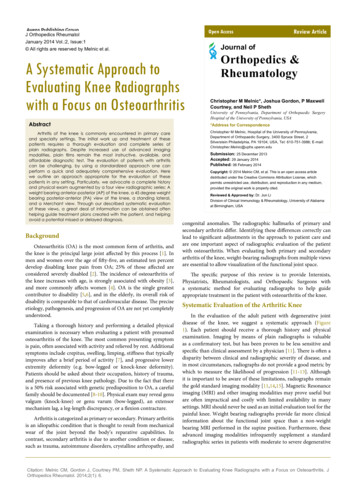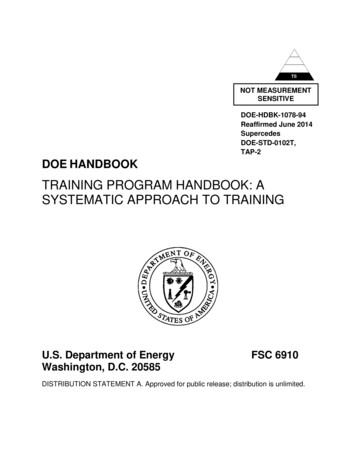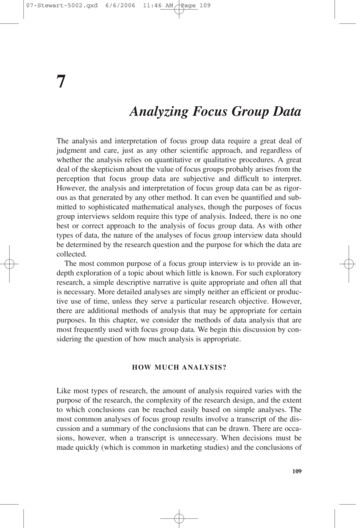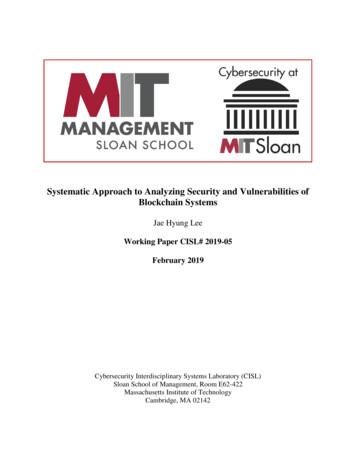
Transcription
Systematic Approach to Analyzing Security and Vulnerabilities ofBlockchain SystemsJae Hyung LeeWorking Paper CISL# 2019-05February 2019Cybersecurity Interdisciplinary Systems Laboratory (CISL)Sloan School of Management, Room E62-422Massachusetts Institute of TechnologyCambridge, MA 02142
Systematic Approach to Analyzing Security and Vulnerabilities of Blockchain SystemsbyJae Hyung LeeB.S., University of Oregon (2001)M.S., Carnegie Mellon University (2004)Submitted to the System Design and Management Programin Partial Fulfillment of the Requirements for the Degree ofMaster of Science in Engineering and Managementat theMassachusetts Institute of TechnologyFebruary 2019 2019 Massachusetts Institute of Technology. All rights reservedSignature of AuthorSystem Design and ManagementJanuary 18, 2019Certified byStuart MadnickJohn Norris Maguire Professor of Information Technologies, MIT Sloan School of Management &Professor of Engineering Systems, MIT School of EngineeringThesis SupervisorAccepted byJoan RubinExecutive Director, System Design & Management Program
THIS PAGE INTENTIONALLY LEFT BLANK2
AcknowledgementForemost, I would like to express my sincere gratitude to my thesis supervisor Prof. StuartMadnick for everything about this paper. This work would not have been possible without hisencouragements and directions. His challenges brought this work towards a completion.My sincere thanks also goes to MIT SDM program, including the faculty, staff and classmates; ithas been a wonderful experience and learning opportunity. Special thanks to Pat Hale, whowelcomed to the SDM conference 4 years ago, later encouraged me to apply.Nobody has been more important to me in the pursuit of this project than the members of myfamily. I would like to thank my parents, whose love and guidance are with me in whatever Ipursue. They are the ultimate role models. I am also very thankful to my two wonderful children,Anais and Ines, who provide unending inspiration. Most importantly, I wish to truly and deeplythank my loving and supportive wife, Eunhee. This thesis is heartily dedicated to her whoencouraged me and prayed for me throughout the time of my research.3
THIS PAGE INTENTIONALLY LEFT BLANK4
Systematic Approach to Analyzing Security andVulnerabilities of Blockchain SystemsbyJae Hyung LeeSubmitted to the System Design and Management Program on January 18, 2019in Partial Fulfillment of the Requirements for the Degree ofMaster of Science in Engineering and ManagementABSTRACTRecent hacks into blockchain systems and heists from such systems have raised serious questionsabout whether this new technology can be secured from ongoing, evolving cyberattacks. Whilethe technology is known to provide an environment that is fundamentally safer than otherexisting centralized systems offer, security professionals warn that the current blockchainecosystem is still immature, harboring many known as well as unknown defects [1].This thesis draws upon a number of research studies and various other inquiries into blockchainsystems security. In addition, this paper gathers and summarizes information regarding 78 recentblockchain cyberattacks and heists, analyzing and categorizing them as to their cause: platformbreach, dApps exploit, access point attack, or endpoint hacking. Two of these attacks (theEthereum blockchain system and the Bitfinex cryptocurrency exchange) are analyzed in detailusing Causal Analysis using System Theory (CAST) method.A novel top-down security assessment method inspired by System Theoretic Process Analysisfor Security (STPA-Sec) is used to evaluate a sample blockchain system, such as might beproposed for voting. An analysis of possible vulnerabilities is conducted, and suggestions forremediation and protection.Thesis SupervisorTitle::Stuart MadnickJohn Norris Maguire Professor of Information Technologies,5
MIT Sloan School of Management & Professor of EngineeringSystems, MIT School of Engineering6
THIS PAGE INTENTIONALLY LEFT BLANK7
Table of ContentsCHAPTER 1 - Introduction . 161.1 Blockchain fever . 161.2 The revolution of system safety and security . 171.3 Motivation of research . 181.4 Thesis questions. 191.5 Research and exercise . 201.6 Structure of thesis paper . 21CHAPTER 2 - Database for Autonomous Systems . 232.1 The birth of blockchain technology . 232.2 The Realization of DAO . 232.3 How does Blockchain work? . 252.4 Technology for autonomous data management, but not for security. 29CHAPTER 3 – Blockchain System Security Domains. 313.1 Blockchain is decentralized, but its system is not . 313.2 Difficulty securing a decentralized system in autonomous operation . 323.3 Threat modeling. 353.4 Four security domains of Blockchain system . 37CHAPTER 4 - Cyberattacks against Blockchain Systems . 394.1 Major cybersecurity incidents in the Blockchain system . 394.2 Increasing loss due to cyberattacks. 534.3 Cyberattacks in terms of security domain . 544.4 Cyberattacks for considerable periods of time . 564.5 Victims of cyberattacks over multiple times . 584.6 Fatalities from cyberattacks . 594.7 Patterns of the cyberattacks . 594.8 Identified cyberattacks and security vulnerabilities. 61CHAPTER 5 - Causal Analysis of Hacking Incidents in Blockchain Systems . 655.1 Causal analysis for security incidents in a Blockchain system. 658
5.2 Ethereum Blockchain heists . 67Causal Analysis #1 – “TheDAO” hack . 67Causal Analysis #2 – first Parity Wallet Hack . 78Causal Analysis #3 – second Parity Wallet Hack . 845.3 Bitfinex cryptocurrency exchange heists . 885.4 Identified security weakness from causal analysis . 94CHAPTER 6 – Security Remediation Approach of Blockchain System . 1006.1 The myth of Blockchain system security. 1006.2 Difficulties in Blockchain system security . 1056.3 Remediation approach of Blockchain system security issues . 106CHAPTER 7 – Security Assessment Method for a Blockchain System . 1097.1 Needs to detect and address potential security issue . 1097.2 Proposal for a security assessment method for the Blockchain system . 1107.3 Application of the security assessment method to Blockchain systems . 112CHAPTER 8 – Summary and Future Work . 119Appendix A - Yearly Loss of Heist due to Cyber Attack in Blockchain Systems . 122Bibliography . 1249
List of FiguresFIGURE 1. 1 – EARLY INVESTMENT OF FINANCIAL SERVICES INDUSTRY IN BLOCKCHAIN [6]. . 16FIGURE 1. 2 – SIZE OF THE BLOCKCHAIN TECHNOLOGY MARKET PROJECTION FROM 2016 TO 2021 INWORLD WIDE [9]. 17FIGURE 1. 3 – BIGGEST CRYPTO CURRENCY HACKS IN DOLLAR AMOUNT, AS OF DEC. 2017 [12]. . 18FIGURE 1. 4 – STRUCTURE OF THIS THESIS PAPER. . 22FIGURE 2. 1 – BRIEF HISTORY OF BLOCKCHAIN [16]. . 23FIGURE 2. 2 – OVERVIEW OF AUTONOMOUS OPERATION IN CRYPTO CURRENCY BLOCKCHAIN SYSTEM. . 25FIGURE 2. 3 – OVERVIEW OF HOW A BLOCK IS ADDED TO BLOCKCHAIN. . 26FIGURE 2. 4 – BLOCK MINING REQUIRES CALCULATION OF “PROOF OF WORK” AND THE CALCULATION ISGOING TO BE USED AS BLOCK HASH (BLOCK ID). . 27FIGURE 2. 5 – APPENDING BLOCKS TO BLOCKCHAIN IN SIMPLE VIEW. . 29FIGURE 3. 1 – SIMPLIFIED DATA FLOW IN BLOCKCHAIN SYSTEM. . 33FIGURE 3. 2 – DISTRIBUTED (BLOCKCHAIN) VS. CENTRALIZED SYSTEM: TO EXPLOIT CENTRALIZEDSYSTEM, ATTACKER SHOULD BE ABLE TO PENETRATE OR BYPASS FIREWALL, INTRUSION DETECTIONSYSTEM, NETWORK MONITORING TO REACH ACTUAL HACKING TARGETS SUCH AS DATABASE,APPLICATION SERVER ETC. HOWEVER, A BLOCKCHAIN SYSTEM CONTAINS SUSTAINABLY FEWERSECURITY RELATED COMPONENTS THAT PROTECT AND MONITOR CYBER THREATS THANCENTRALIZED SYSTEM DOES. THERE IS NO SECURITY SYSTEM CONTROL COMPONENT OTHER THANUSER AUTHENTICATION IN BLOCKCHAIN SYSTEM BOUNDARY. . 34FIGURE 3. 3 – RESULTS OF THREAT MODELING ON BLOCKCHAIN SYSTEM. . 35FIGURE 3. 4 – FOUR BLOCKCHAIN SYSTEM SECURITY DOMAINS ARE CATEGORIZED THROUGHOUT THREATMODELING EXERCISES IN SECTION 3.3 [41]. . 37FIGURE 4. 1 – NUMBER OF PUBLIC NOTABLE HEIST AGAINST BLOCKCHAIN SYSTEM IN RECENT YEARS. . 53FIGURE 4. 2 – CONTRIBUTION TO FINANCIAL LOSS FROM EACH SECURITY DOMAIN IN TERMS OFPERCENTAGE. 56FIGURE 4. 3 – TYPES OF CYBERATTACKS AFFECTED MULTIPLE BLOCKCHAIN SYSTEMS OVER SHORT TIMEPERIOD. . 57FIGURE 4. 4 – NUMBER OF BLOCKCHAIN SYSTEMS, WHICH EXPERIENCED MULTIPLE CYBERATTACKS(GREY), OVER TOTAL NUMBER OF CYBERATTACKS (BLACK PLUS GREY) IN THE YEAR. . 5910
FIGURE 4. 5– NUMBER OF CLOSE OF BUSINESS ORGANIZATIONS DUE TO THE CYBERATTACKS (GREY) OVERTOTAL NUMBER OF CYBERATTACKS (BLACK PLUS GREY) IN THE YEAR. . 59FIGURE 5. 1 – NORMAL FLUX OF THE FUND IN “THEDAO” OPERATION . PLEASE NOTE THE ARROWSINDICATE SYSTEM OPERATION WITH ASSOCIATED ACTUAL FUNCTION INVOCATION(S) IN SOURCECODE, SUCH AS “SEND ()”, “SPLITDAO ()”, “EXECUTEPROPOSAL ()”, “RETRIEVEDAOREWARD ()”,AND “GETMYREWARD ()” [239]. 68FIGURE 5. 2 – SIMPLIFIED VIEW OF DATA COMMUNICATION AMONG NODE (USER), DAPPS ANDBLOCKCHAIN IN ETHEREUM BLOCKCHAIN SYSTEM [249]. PLEASE NOTE THAT THEAUTHENTICATION REQUEST AS COLORED IN RED IS THE ONLY SECURITY VERIFICATION IN DATATRANSITIONS AMONG THEM. . 70FIGURE 5. 3 – THE RED COLORED LINES AND DESCRIPTION ILLUSTRATE PREPARATION AND EXECUTION OF“THEDAO” HACK IN HIGH LEVEL VIEW. DETAILS OF EACH PHASE IS DESCRIBED IN EVENT CHAIN. . 71FIGURE 5. 4 – THE SIMPLIFIED VIEW OF RE-ENTRY ATTACK TARGETED TO “THEDAO” [283]. 76FIGURE 5. 5 - AFTER THE SOFT FORK (CORE UPGRADE), VERSION 1 BLOCKCHAIN (VERSION 1) WILLACCEPT THE NEW BLOCK (VERSION 2), BUT WILL NOT ACCEPT OLD BLOCK (VERSION 1).EVENTUALLY THE OLD BLOCKS WILL DIE OUT SINCE VERSION 1 BLOCK WILL NOT BE MINED ANYLONGER. 77FIGURE 5. 6 - BLOCKCHAIN A WILL NOT ACCEPT BLOCKCHAIN B’S BLOCK, AND VICE VERSA, SO HARDFORK IS NOT BACKWARDS COMPATIBLE. UNLIKE A SOFT FORK, THE OLD BLOCKCHAIN A DOES NOTDIE OUT AND CONTINUE EXISTING AND WORKING. THE CHAIN SPLITS INTO TWO SEPARATE CHAINS,THAT SHARE THE SAME TRANSACTION HISTORY AS BEFORE THE SPLIT. . 77FIGURE 5. 7 – BITGO GENERATES PRIVATE KEY AND BREAKS THE PRIVATE KEY INTO 3 PIECES. 1ST PIECE ISSTORED IN BITFINEX, AND 2ND PIECE IS STORED AT BITGO, AND 3RD PIECE IS STORED AT OFFLINESTORAGE [335]. . 90FIGURE 5. 8 – THE BITGO’S MULTI-SIG SOLUTION REQUIRES A USER AT LEAST 2 OUT OF 3 PIECES OFPRIVATE KEY TO AUTHORIZE DATA TRANSACTION. IN THIS IMPLEMENTATION OF BITFINEX ANDBITGO, TO COMPLETE DATA TRANSACTION, A USER SHOULD PROVIDE TWO PIECES OF THE PRIVATEKEY. ONE KEY IS GOING TO BE PROVIDED FROM EITHER USER'S OFFLINE KEY STORAGE OR FROMBITFINEX THROUGH LOGIN. THE OTHER KEY IS GOING TO BE PROVIDED FROM BITGO THROUGHSEPARATE LOGIN [339]. . 91FIGURE 5. 9 – BRIEF ILLUSTRATION OF HOW ATTACKER WAS ABLE TO EXPLOIT BITFINEX WITHBYPASSING THE 3RD PARTY MULTI-SIG AUTHENTICATION PROVIDED BY BITGO [351]. . 9311
FIGURE 5. 10 - ETHEREUM HAS A FORM OF SECURITY DECISION HIERARCHY AS CENTRALIZED SYSTEM.ETHEREUM DEVELOPMENT COMMUNITY HAVE BEEN PLAYING LIKE CENTRAL AUTHORITY ATOCCURRENCE OF CYBER INCIDENT. . 98FIGURE 6. 1 – SIMPLE ILLUSTRATION OF 51% ATTACK. 101FIGURE 6. 2 – PURCHASE INFORMATION WITHIN SESSION ID OR COOKIES MAY BE ABUSED TO LINK THEMWITH TRANSACTION IN BLOCKCHAIN [377]. . 103FIGURE 6. 3 – TYPICAL CARRY OUT OF NETWORK-BASED ATM MALWARE ATTACK BETWEENBLOCKCHAIN VS. CENTRALIZED SYSTEM [378]. . 105FIGURE 7. 1 – FLOW DIAGRAM OF THE PROPOSED SECURITY ASSESSMENT METHODOLOGY FORBLOCKCHAIN SYSTEM. . 112FIGURE 7. 2 – OVERVIEW OF SIMPLIFIED DISTRIBUTED VOTING APPLICATION BASED ON ETHEREUMSYSTEM [385]. . 112FIGURE 7. 3 – SIMPLIFIED SYSTEM COMPONENT DIAGRAM OF SMART CONTRACT VOTING SYSTEM.SQUARES ARE SYSTEM COMPONENTS AND ATTACHED TRIANGLE CONTAINS SYSTEM COMPONENTNUMBER(S) FOR CONVENTION. . 11312
List of TablesTABLE 1. 1 – MAIN ADVANTAGES OF BLOCKCHAIN TECHNOLOGY FOR CYBER SECURITY [11]. . 17TABLE 2. 1 – BLOCKCHAIN VS. CENTRALIZED DATABASE IN FINANCIAL IT SYSTEM [31] . 30TABLE 3. 1 – SIMPLIFIED LIST OF BLOCKCHAIN SYSTEM COMPONENTS [38]. . 32TABLE 3. 2 – MAPPING BETWEEN 6 SYSTEM SECURITY THREATS (ROWS) THROUGH THREAT MODELINGBASED ON FIGURE 3.1 AND 17 POTENTIAL SECURITY RISKS (COLUMNS) IN BLOCKCHAIN SYSTEMBASED ON THE 6 DISCOVERED SYSTEM SECURITY THREATS BASED ON FIGURE 3.3. . 37TABLE 4. 1 – MAJOR CYBERATTACKS AGAINST BLOCKCHAIN SYSTEM BETWEEN 2011 1ST QUARTER AND2018 2ND QUARTER. . 52TABLE 4. 2 – PUBLIC NOTABLE LOSS BY CYBERATTACK AGAINST BLOCKCHAIN SYSTEM. . 54TABLE 4. 3 – NUMBER OF CYBERATTACKS AGAINST BLOCKCHAIN SYSTEM IN SECURITY DOMAIN. . 55TABLE 4. 4 – AVERAGE FINANCIAL LOSS PER INCIDENT AGAINST BLOCKCHAIN SYSTEM IN TERMS OFSECURITY DOMAIN SINCE 2011. 55TABLE 4. 5 – TYPES OF CYBERATTACKS AFFECTED MULTIPLE BLOCKCHAIN SYSTEMS OVER SHORTPERIOD. . 58TABLE 4. 6 – COMPARISON OF CYBERATTACK METHODOLOGY BETWEEN CENTRALIZED ANDDECENTRALIZED (BLOCKCHAIN) SYSTEM [203]. . 61TABLE 4. 7 – IDENTIFIED CYBERATTACKS AND SECURITY VULNERABILITIES OF BLOCKCHAIN SYSTEMFROM SECTION 4.1 AND THEIR CONSEQUENCES. . 64TABLE 5. 1 – CAUSAL ANALYSIS STEPS FOR SERIES OF HEISTS AGAINST A BLOCKCHAIN SYSTEM [206]. . 66TABLE 5. 2 - SECURITY FEATURES INHERITED FROM BLOCKCHAIN TECHNOLOGY. . 95TABLE 6. 1 – DIFFERENT TYPES OF FORKS IN TERMS OF COMPATIBILITY [346]. . 100TABLE 6. 2 – THREATS OF SYSTEM SAFETY DUE TO TRANSPARENCY IN PUBLIC BLOCKCHAIN SYSTEM.104TABLE 6. 3 – LIST OF RECOMMENDED SECURITY RES
Jan 18, 2019 · A novel top-down security assessment method inspired by System Theoretic Process Analysis for Security (STPA-Sec) is used to evaluate a sample blockchain system, such as might be proposed for voting. An analysis of possible vulnerabilities
